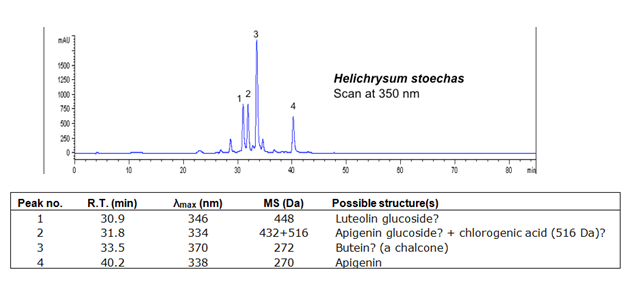Difference between revisions of "Strawflower (Helichrysum stoechas)"
| (4 intermediate revisions by 2 users not shown) | |||
| Line 7: | Line 7: | ||
| − | = Summary of results = | + | == Summary of results == |
| − | = Analytical instrumentation and procedures = | + | == Analytical instrumentation and procedures == |
| + | HPLC-DAD-MS analysis was performed with an Agilent 1100 liquid chromatography system consisting of an automatic injector, a gradient pump, a HP series 1100 DAD, and an Agilent series 1100 VL on-line atmospheric pressure ionization electrospray ionization mass spectrometer. Separations were done on a Vydac 214TP52 analytical column (2.1 mm diameterX250 mm; 5-ím particle size). The column was eluted at a flow rate of 0.2 mL/min with a tertiary gradient of water (A),acetonitrile (B), and 1% (v/v) aqueous formic acid (C) with the following elution program: 0 min, 90% A, 5% B, 5% C; 0-55 min, a linear gradient to 35% A, 60% B, 5% C; 55-60 min, a linear gradient elution to 15% A, 80% B, 5% C; 60-62 min, isocratic elution at 15% A, 80% B, 5% C; 62-70 min gradient elution to 90% A, 5% B, 5% C; and reequilibration with the latter solvent for 15 min. The mass spectrometer was run both in the negative and positive ion mode. | ||
| − | = Chromatograms = | + | == Chromatograms == |
[[File:Strawflower LC.PNG|center|frame|Absorbance at 350nm (mAU)]] | [[File:Strawflower LC.PNG|center|frame|Absorbance at 350nm (mAU)]] | ||
| − | Note:Acid hydrolysis gives nearly equal amounts of luteolin and apigenin as the primary products | + | Note:Acid hydrolysis gives nearly equal amounts of luteolin and apigenin as the primary products |
| − | Sample information | + | == Sample information == |
| − | [[File:. | + | [[File:Strawflower info.PNG|center|frame|sample information, By R. A. Laursen, Boston University ]] |
| − | = Identified compounds = | + | == Identified compounds == |
[[[SliderGallery rightalign|~HPLC-DAD|.JPG~ UV-Vis|.jpg~ UV-Vis]]] | [[[SliderGallery rightalign|~HPLC-DAD|.JPG~ UV-Vis|.jpg~ UV-Vis]]] | ||
| Line 70: | Line 71: | ||
| − | [[Category:Analysis | + | [[Category:Dye Analysis]] |
| + | [[Category:Reference Materials]] | ||
| + | [[Category:Natural Dyes]] | ||
Latest revision as of 09:21, 29 September 2017
[[File:|thumb|Yellow Botanic Gardens]]
Description
Historical importance
Summary of results
Analytical instrumentation and procedures
HPLC-DAD-MS analysis was performed with an Agilent 1100 liquid chromatography system consisting of an automatic injector, a gradient pump, a HP series 1100 DAD, and an Agilent series 1100 VL on-line atmospheric pressure ionization electrospray ionization mass spectrometer. Separations were done on a Vydac 214TP52 analytical column (2.1 mm diameterX250 mm; 5-ím particle size). The column was eluted at a flow rate of 0.2 mL/min with a tertiary gradient of water (A),acetonitrile (B), and 1% (v/v) aqueous formic acid (C) with the following elution program: 0 min, 90% A, 5% B, 5% C; 0-55 min, a linear gradient to 35% A, 60% B, 5% C; 55-60 min, a linear gradient elution to 15% A, 80% B, 5% C; 60-62 min, isocratic elution at 15% A, 80% B, 5% C; 62-70 min gradient elution to 90% A, 5% B, 5% C; and reequilibration with the latter solvent for 15 min. The mass spectrometer was run both in the negative and positive ion mode.
Chromatograms
Note:Acid hydrolysis gives nearly equal amounts of luteolin and apigenin as the primary products
Sample information
Identified compounds
| Compound | RT (min.) | MW | UV/vis | Other |
|---|---|---|---|---|
| xx | xx0 | xx | xx | Comments here |
| x | x | x | x | |
| x | x | x | x | |
| x | x | x | x |
References
[1] [2] [3]

